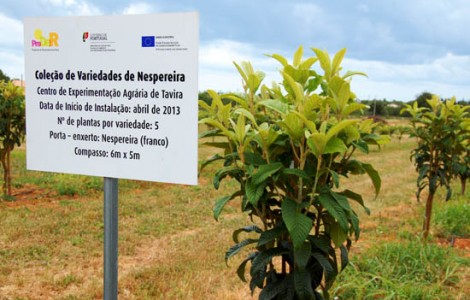 'Bird's Beak', 'Pig's Tail', 'Romana', 'Mulata', 'Dolly's Tail', 'Lourecinha'. These are just a few of the names of the hundreds of varieties of six species of Algarve fruit trees that make up the collection of the Tavira Agricultural Experimentation Center, belonging to the Regional Directorate of Agriculture and Fisheries of the Algarve (DRAPAlg).
'Bird's Beak', 'Pig's Tail', 'Romana', 'Mulata', 'Dolly's Tail', 'Lourecinha'. These are just a few of the names of the hundreds of varieties of six species of Algarve fruit trees that make up the collection of the Tavira Agricultural Experimentation Center, belonging to the Regional Directorate of Agriculture and Fisheries of the Algarve (DRAPAlg).
Thousands of trees of traditional Algarve varieties of pomegranate, loquat, almond, apple (in this case, Monchique pear), carob and fig trees are lined up on the grounds of the former Agricultural Post of Tavira, next to the train station. There is also a collection of citrus fruits, although most of the specimens are in Patacão, near Faro, on land also belonging to that Regional Directorate. Or the collection of traditional vine varieties.
Many of these trees result from the patient collection made by António Marreiros, João Costa and their team, in the Algarve countryside, always looking for “that” tree and “that” variety of fruit trees, which can be very different from the one that is just a short distance away. distance. The objective is to preserve the diversity of fruit tree varieties existing in the region, selected over centuries, perhaps millennia, by generations and generations of farmers, and which now find themselves threatened by the introduction of varieties from abroad, eventually capable of guaranteeing higher productions and, therefore, higher yields.
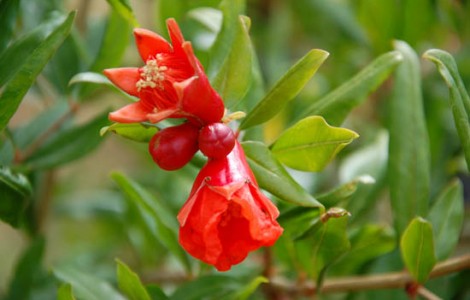 Altogether, António Marreiros told the Sul Informação, there are 122 varieties of almond, 19 of loquat, 26 of Monchique pear, 56 of pomegranate, 44 of carob and 97 varieties of fig.
Altogether, António Marreiros told the Sul Informação, there are 122 varieties of almond, 19 of loquat, 26 of Monchique pear, 56 of pomegranate, 44 of carob and 97 varieties of fig.
The work of prospecting, collecting, preserving and characterizing plant materials from the Algarve fruit trees has been carried out for years by DRAPAlg, as has been done with different species and varieties in other parts of the country. But in 2011 a project was submitted to PRODER, which will end at the end of this year.
To get to know this collection of fruit trees, a visit was made this week to the Tavira Agricultural Experimentation Center (CEAT), an activity that opened a seminar dedicated to the Mediterranean Diet and promoted by Animar – Portuguese Association for Local Development, in partnership with the National Institute of Agrarian and Veterinary Research (INIAV), the Municipality of Tavira and the Instituto Superior de Agronomia.
"The idea of the fruit tree collection is to preserve these traditional varieties, which are disappearing due to lack of interest from farmers, but it was felt that one day they may become important again, even because of the contribution they can make to obtaining new varieties, through genetic improvement», explained António Marreiros to Sul Informação, which accompanied the visit.
«We have here plant materials collected from all the Algarve's municipalities. Basically, we are interested in conserving biodiversity. For this, it is preferable to have material from Vila Real de Santo António and material from Aljezur, than to have only from Tavira and Olhão, because this guarantees us, from the start, greater diversity. Today it is easy to travel from one end of the Algarve to the other, but in the past it was difficult for material from Vila Real to reach Aljezur», explained that engineer.
Pêro de Monchique is already in the collection
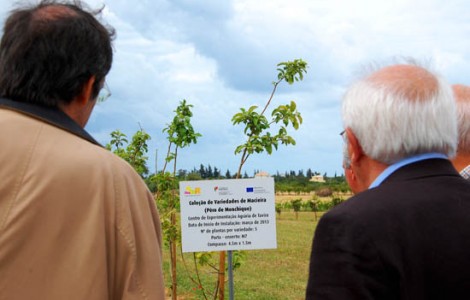 One of the most interesting collections is the so-called Monchique pear, actually an apple. This fruit once had great economic importance and was sold throughout the region. In autumn fairs, such as Santa Iria, in Faro, recalls António Marreiros, «I felt that little smell of the Monchique pears, when I was young».
One of the most interesting collections is the so-called Monchique pear, actually an apple. This fruit once had great economic importance and was sold throughout the region. In autumn fairs, such as Santa Iria, in Faro, recalls António Marreiros, «I felt that little smell of the Monchique pears, when I was young».
On CEAT's land, the Monchique pear trees, planted last year from material collected in various points in the municipalities of Monchique, Aljezur and north of Portimão (Mexilhoeira Grande parish), are not «in their manor», or whether in your home location where conditions are best. The terrain is different, the water is different and the climate is much hotter and drier than in the mountains. «But what matters is that we have the preserved material here», explains António Marreiros. “If one day the Monchique Council, which has been investing in the value of traditional products from the mountains, wants to promote the cultivation of this pear, it can come here to get the material”, adds the technician.
The work of collecting plant material has been long and laborious. The technicians involved in the project have been walking through hills and valleys in search of the countless varieties of fruit trees of those six species. Sometimes, they arrive at a certain tree through the indication of a neighbor, who tells them “that loquat tree there, which gives loquats sweet as honey”. It's almost detective work, looking for the (almost) lost trees.
Afterwards, all the material is properly identified, with the name and georeference of the place where it was collected, the name of the owner (if any), the name of the variety as it is known in that place, among many other data.
“There are many varieties that don't even have a name. When this happens, we name the owner of that tree or the place, if it is not well known». And that is how there are varieties in the Monchique pear orchard with the name “Perna da Negra” or “Bemveja”, in honor of the places where the material was collected.
João Costa, responsible for the varieties of trees that produce dried fruit – carob, almond and fig trees – recalls the case of the “famous carob tree of Arrifes”, in the Cacela area. “Everyone told us about this carob tree, saying that that was where they had gone to get the material to graft their carob trees. Of course we went to discover it».
Or even the case of «Mulata da Parra», a giant carob tree existing in the Parra area, near Moncarapacho, which is classified as a monument, «has a trunk measuring twelve meters in perimeter and came to bear 60 arrobas of carob». It is a genetic material of great value and, therefore, underlines João Costa, «of course Mulata da Parra is also here, in our collection».
Small region but with huge diversity
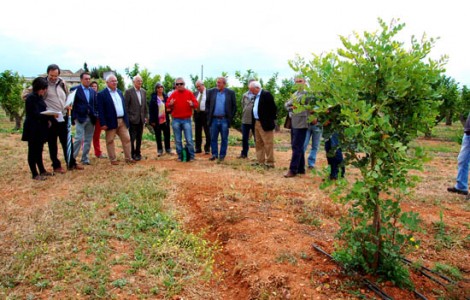 «The Algarve is a small region, but this work of ours allowed us to verify the immense wealth of this diversity of fruit tree varieties. It is an entire heritage that was selected by our ancestors and that we cannot let loose”, stressed António Marreiros.
«The Algarve is a small region, but this work of ours allowed us to verify the immense wealth of this diversity of fruit tree varieties. It is an entire heritage that was selected by our ancestors and that we cannot let loose”, stressed António Marreiros.
“Our ancestors were great improvers. They did what we have here. They are varieties that have been selected to better adapt to our climate, our terrains, our conditions. And that, if they have already done a lot for the Algarve in the past, they can do even more in the future”, said João Costa, the other person responsible for the Project.
João Costa argues that this collection of fruit trees is not only intended to preserve an immense heritage that would otherwise be lost. «The most important thing about this collection is that all this material, this heritage, is used to guarantee the future of our farming».
And he gives an example: «the carob tree was the species most planted by young farmers in the Algarve in recent times, with the support of PRODER. But a carob orchard currently produces 3,5 tons per hectare and has to produce 10 tons. For this, we have to use the best varieties and good techniques. And these best varieties are here».
bright future, uncertain future
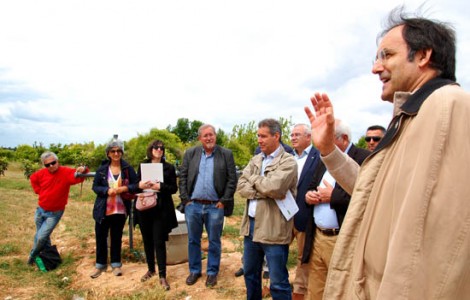 The perspectives for the preservation of traditional fruit tree varieties are now better, at a time when «environmental concerns are growing, while the demand for differentiated products that can be an alternative to massification and allow for creation grows. niche markets», said António Marreiros. Monchique pears, tasty Algarvian loquats, May and June figs lampos are products that are only produced in the region and that, with gourmet fashion, can have a market that makes their production viable again. But to take advantage of this diversity that differentiates the Algarve, it is necessary, first of all, to preserve it.
The perspectives for the preservation of traditional fruit tree varieties are now better, at a time when «environmental concerns are growing, while the demand for differentiated products that can be an alternative to massification and allow for creation grows. niche markets», said António Marreiros. Monchique pears, tasty Algarvian loquats, May and June figs lampos are products that are only produced in the region and that, with gourmet fashion, can have a market that makes their production viable again. But to take advantage of this diversity that differentiates the Algarve, it is necessary, first of all, to preserve it.
Jorge Queiroz, director of the Museum of Tavira and responsible for the municipality's candidacy, as a representative community of Portugal, for the victorious classification of the Mediterranean Diet as a World Heritage Site, also accompanied the visit to the fruit tree collection and made a point of saying that «all these collections they fit very well with the objectives of the Mediterranean Diet».
“This is fundamental in terms of maintaining the biodiversity of the country and the Planet itself. They are essential resources for the future of farmers. Therefore, this work of knowing, studying and then putting all this heritage at the service of farmers is very important».
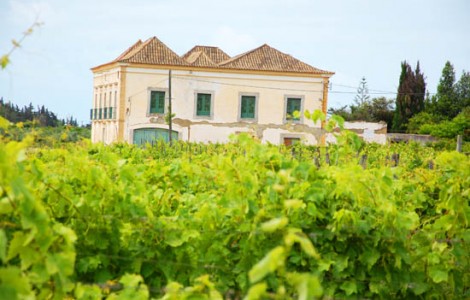 Jorge Queiroz also told the Sul Informação that, more than nutrition issues, the Mediterranean Diet is about “ways of producing food” and with a wealth of “variety and uses”. Therefore, he considers, this project is "doing an extraordinary job!"
Jorge Queiroz also told the Sul Informação that, more than nutrition issues, the Mediterranean Diet is about “ways of producing food” and with a wealth of “variety and uses”. Therefore, he considers, this project is "doing an extraordinary job!"
However, he underlined, “there is now a big question regarding the future: PRODER has ended, how is this project going to continue? It's just that the country can't miss it!”.
With the technicians responsible for the project making great strides towards the reform and with the scarce human resources of the CEA of Tavira (agricultural workers have to come from Patacão to support the fruit tree collection), the fear now arises that all the work may get by the way.
Even more when, as António Marreiros and João Costa pointed out, there is still a lot to do, not to mention the care that the orchards of the fruit tree collection need permanently. “This is not a closed job. There is always the possibility of more varieties appearing in the field», said João Costa.
And then there is all the work on the characterization that remains to be done, namely genetics. And there are fruit trees that would also be interesting to preserve and that are not yet in the collection, such as plums, pears or even quinces. And… «This is a work that never ends. But we need to continue to be able to do it», stressed António Marreiros.
Vítor Barros, from the National Institute of Agrarian and Veterinary Research, a member of Animar, concluded: «this project must continue, because it is very important for the country». Hopefully someone hears you.


















Comments